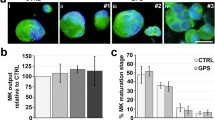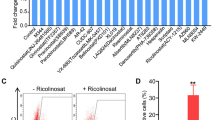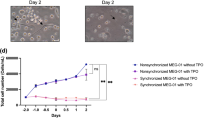Abstract
Platelet function tests utilizing agonists or patient serum are generally performed to assess platelet activation ex vivo. However, inter-individual differences in platelet reactivity and donor requirements make it difficult to standardize these tests. Here, we established a megakaryoblastic cell line for the conventional assessment of platelet activation. We first compared intracellular signaling pathways using CD32 crosslinking in several megakaryoblastic cell lines, including CMK, UT-7/TPO, and MEG-01 cells. We confirmed that CD32 was abundantly expressed on the cell surface, and that intracellular calcium mobilization and tyrosine phosphorylation occurred after CD32 crosslinking. We next employed GCaMP6s, a highly sensitive calcium indicator, to facilitate the detection of calcium mobilization by transducing CMK and MEG-01 cells with a plasmid harboring GCaMP6s under the control of the human elongation factor-1α promoter. Cells that stably expressed GCaMP6s emitted enhanced green fluorescent protein fluorescence in response to intracellular calcium mobilization following agonist stimulation in the absence of pretreatment. In summary, we have established megakaryoblastic cell lines that mimic platelets by mobilizing intracellular calcium in response to several agonists. These cell lines can potentially be utilized in high-throughput screening assays for the discovery of new antiplatelet drugs or diagnosis of disorders caused by platelet-activating substances.





Similar content being viewed by others
References
Holinstat M. Normal platelet function. Cancer Metastasis Rev. 2017;36:195–8.
Jamasbi J, Ayabe K, Goto S, Nieswandt B, Peter K, Siess W. Platelet receptors as therapeutic targets: past, present and future. Thromb Haemost. 2017;117:1249–57.
Born GV, Cross MJ. The aggregation of blood platelets. J Physiol. 1963;168:178–95.
Carr ME Jr. In vitro assessment of platelet function. Transfus Med Rev. 1997;11:106–15.
Fritsma GA, McGlasson DL. Whole blood platelet aggregometry. Methods Mol Biol. 2017;1646:333–47.
Paniccia R, Priora R, Liotta AA, Abbate R. Platelet function tests: a comparative review. Vasc Health Risk Manag. 2015;11:133–48.
Arepally GM. Heparin-induced thrombocytopenia. Blood. 2017;129:2864–72.
Reilly MP, McKenzie SE. Insights from mouse models of heparin-induced thrombocytopenia and thrombosis. Curr Opin Hematol. 2002;9:395–400.
Favaloro EJ, McCaughan G, Pasalic L. Clinical and laboratory diagnosis of heparin induced thrombocytopenia: an update. Pathology. 2017;49:346–55.
Minet V, Dogne JM, Mullier F. Functional assays in the diagnosis of heparin-induced thrombocytopenia: a review. Molecules. 2017. https://doi.org/10.3390/molecules22040617.
Inoue O, Suzuki-Inoue K, Shinoda D, Umeda Y, Uchino M, Takasaki S, Ozaki Y. Novel synthetic collagen fibers, poly(PHG), stimulate platelet aggregation through glycoprotein VI. FEBS Lett. 2009;583:81–7.
Nagano T, Ohga S, Kishimoto Y, Kimura T, Yasunaga K, Adachi M, Ryo R, et al. Ultrastructural analysis of platelet-like particles from a human megakaryocytic leukemia cell line (CMK 11–5). Int J Hematol. 1992;56:67–78.
Sakata A, Ohmori T, Nishimura S, Suzuki H, Madoiwa S, Mimuro J, Kario K, et al. Paxillin is an intrinsic negative regulator of platelet activation in mice. Thromb J. 2014;12:1.
Poenie M, Tsien R. Fura-2: a powerful new tool for measuring and imaging [Ca2+]i in single cells. Prog Clin Biol Res. 1986;210:53–6.
Chen TW, Wardill TJ, Sun Y, Pulver SR, Renninger SL, Baohan A, Schreiter ER, et al. Ultrasensitive fluorescent proteins for imaging neuronal activity. Nature. 2013;499:295–300.
Rivera J, Lozano ML, Navarro-Nunez L, Vicente V. Platelet receptors and signaling in the dynamics of thrombus formation. Haematologica. 2009;94:700–11.
Keely PJ, Parise LV. The alpha2beta1 integrin is a necessary co-receptor for collagen-induced activation of Syk and the subsequent phosphorylation of phospholipase Cgamma2 in platelets. J Biol Chem. 1996;271:26668–766.
Ogletree ML, Harris DN, Greenberg R, Haslanger MF, Nakane M. Pharmacological actions of SQ 29,548, a novel selective thromboxane antagonist. J Pharmacol Exp Ther. 1985;234:435–41.
Baurand A, Gachet C. The P2Y(1) receptor as a target for new antithrombotic drugs: a review of the P2Y(1) antagonist MRS-2179. Cardiovasc Drug Rev. 2003;21:67–766.
Ogura M, Morishima Y, Ohno R, Kato Y, Hirabayashi N, Nagura H, Saito H. Establishment of a novel human megakaryoblastic leukemia cell line, MEG-01, with positive Philadelphia chromosome. Blood. 1985;66:1384–92.
Kashiwagi H, Shiraga M, Honda S, Kosugi S, Kamae T, Kato H, Kurata Y, et al. Activation of integrin alpha IIb beta 3 in the glycoprotein Ib-high population of a megakaryocytic cell line, CMK, by inside-out signaling. J Thromb Haemost. 2004;2:177–86.
Berlanga O, Bobe R, Becker M, Murphy G, Leduc M, Bon C, Barry FA, et al. Expression of the collagen receptor glycoprotein VI during megakaryocyte differentiation. Blood. 2000;96:2740–5.
Mustard JF, Perry DW, Ardlie NG, Packham MA. Preparation of suspensions of washed platelets from humans. Br J Haematol. 1972;22:193–204.
Odaka H, Arai S, Inoue T, Kitaguchi T. Genetically-encoded yellow fluorescent cAMP indicator with an expanded dynamic range for dual-color imaging. PLoS ONE. 2014;9:e100252.
Tang S, Hu Y, Shen Q, Fang H, Li W, Nie Z, Yao S. Cyclic-AMP-dependent protein kinase (PKA) activity assay based on FRET between cationic conjugated polymer and chromophore-labeled peptide. Analyst. 2014;139:4710–6.
von Kugelgen I. Structure, pharmacology and roles in physiology of the P2Y12 receptor. Adv Exp Med Biol. 2017;1051:123–38.
Zeng X, Chen J, Sanchez JF, Coggiano M, Dillon-Carter O, Petersen J, Freed WJ. Stable expression of hrGFP by mouse embryonic stem cells: promoter activity in the undifferentiated state and during dopaminergic neural differentiation. Stem Cells. 2003;21:647–53.
Wen S, Zhang H, Li Y, Wang N, Zhang W, Yang K, Wu N, et al. Characterization of constitutive promoters for piggyBac transposon-mediated stable transgene expression in mesenchymal stem cells (MSCs). PLoS ONE. 2014;9:e94397.
Daniel JL, Dangelmaier CA, Mada S, Buitrago L, Jin J, Langdon WY, Tsygankov AY, et al. Cbl-b is a novel physiologic regulator of glycoprotein VI-dependent platelet activation. J Biol Chem. 2010;285:17282–91.
Raslan Z, Naseem KM. The control of blood platelets by cAMP signalling. Biochem Soc Trans. 2014;42:289–94.
Acknowledgements
This study was supported by SENSHIN Medical Research Foundation (T.O.), Ishizu Shun Memorial Scholarship (H.S.), and Jichi Medical University Graduate Student Start-up Award (H.S.). Additional funding support was provided by Bayer (T.O.). The authors are grateful to Professor N. Komatsu (Juntendo University) for providing UT-7/TPO cells. The authors also thank Yaeko Suto, Mika Kishimoto, Tamaki Aoki, Hiromi Ozaki, and Hiroko Hayakawa (Jichi Medical University) for their excellent technical assistance. BD LSRFortessa (BD Biosciences) used in this study was subsidized by JKA through its promotion funds from KEIRIN RACE. The authors would like to thank Enago (www.enago.jp) for the English language review.
Author information
Authors and Affiliations
Corresponding author
Ethics declarations
Conflicts of interest
T.O. received research supports from Mitsubishi-Tanabe, Novo Nordisk, Bayer, Japan Blood Products Organization, Dai-ichi Sankyo, Otsuka, Chugai, and CSL Behring, outside of this study. All other authors declare that they have no competing financial interests.
Additional information
Publisher's Note
Springer Nature remains neutral with regard to jurisdictional claims in published maps and institutional affiliations.
Electronic supplementary material
Below is the link to the electronic supplementary material.

Supplementary file2 (MOV 768 kb)
About this article
Cite this article
Saito, H., Hayakawa, M., Kamoshita, N. et al. Establishment of a megakaryoblastic cell line for conventional assessment of platelet calcium signaling. Int J Hematol 111, 786–794 (2020). https://doi.org/10.1007/s12185-020-02853-6
Received:
Revised:
Accepted:
Published:
Issue Date:
DOI: https://doi.org/10.1007/s12185-020-02853-6




